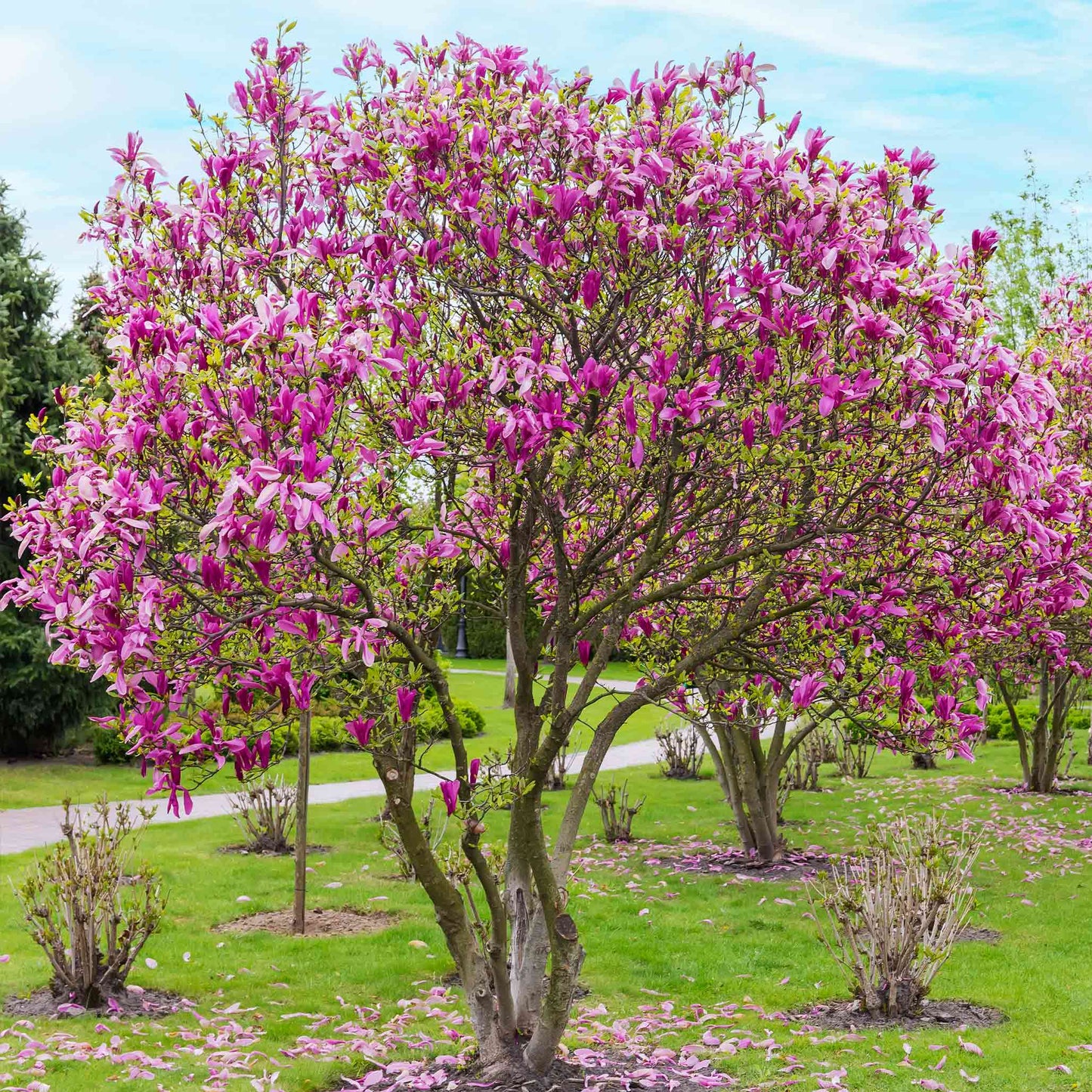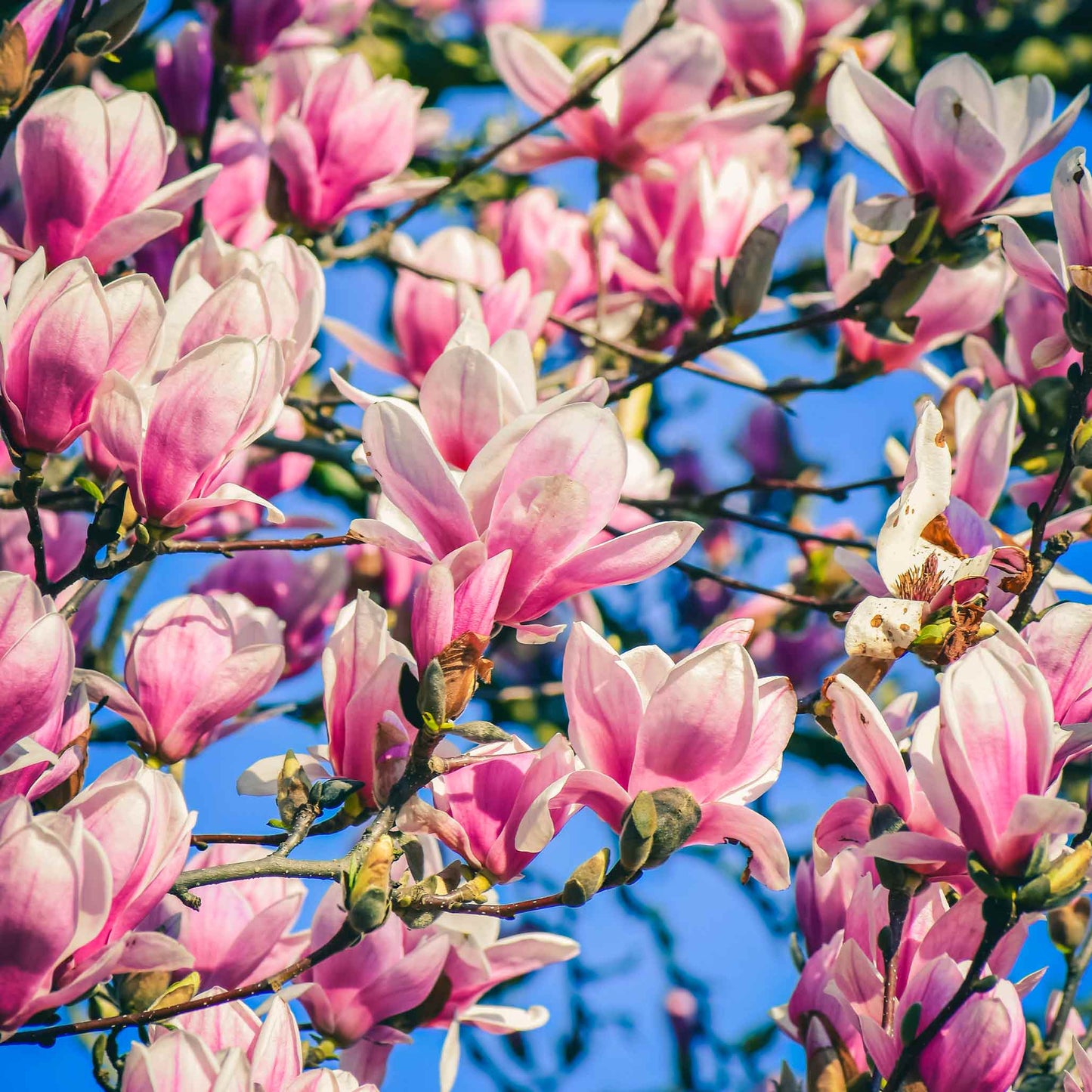Jane Magnolia
Jane Magnolia
SKU:FLT-MAG-JAN-23-3G
Meet the Jane Magnolia: Your Garden's New Best Friend
Imagine stepping into your garden and being greeted by the vibrant purples and pinks of the Jane Magnolia. This charming addition to your outdoor space is not just a feast for the eyes; it's a low-maintenance companion that asks for little but gives so much.
Why You'll Love Jane:
- Compact Beauty: Perfect for smaller gardens, Jane fits in without overwhelming your space.
- Seasonal Showstopper: With blooms that burst forth in early spring, she's the signal that warmer days are ahead.
- Resilient Character: Jane isn't just pretty; she's tough, shrugging off late frosts like a champ.
Easy to Grow, Easier to Adore
Whether you're a seasoned gardener or just starting out, the Jane Magnolia is delightfully uncomplicated. She's adaptable to a variety of soils, and once established, she's drought resistant. This means more time enjoying your garden and less time fussing over it.
A Symphony of Color and Scent
Not only does Jane put on a spectacular color show, but her flowers also come with a subtle, sweet fragrance. It's like having your own natural aromatherapy session right in your backyard.
Invite Jane Over
Ready to add a touch of playful elegance to your garden? The Jane Magnolia is waiting to show off her colors and charm. Let her transform your garden into a place of serene beauty and simple joy.


Product Details
-
Product Category
Flowering Trees
-
Product Subcategory:
Magnolias
-
Botanical Name:
Magnolia x 'Jane'
-
Does Not Ship To:
AZ, OR
-
Mature Height:
10-15 ft.
-
Mature Width:
5-10 ft.
-
Growing Zone:
4-8 outdoors
-
Indoor Growing:
-
Sunlight:
Full-Part Sun
-
Growth Rate:
Moderate
-
Harvest Time:
-
Bloom Time:
Spring

Planting Directions
<h2>Planting Jane Magnolia</h2>
<ul>
<li>Select a planting site with well-draining soil and full sun to partial shade exposure.</li>
<li>Dig a hole twice as wide and just as deep as the root ball of your Jane Magnolia.</li>
<li>Remove the plant from its container and gently tease out any circling roots.</li>
<li>Place the plant in the hole, ensuring it's at the same depth it was in the container.</li>
<li>Backfill the hole with soil, tamping down gently to remove air pockets.</li>
<li>Water thoroughly after planting to settle the soil around the roots.</li>
<li>Apply a 2-3 inch layer of mulch around the base of the plant, avoiding direct contact with the trunk.</li>
</ul>
<h2>Care and Maintenance</h2>
<p>Water your Jane Magnolia regularly during the first growing season to establish a deep, extensive root system. Once established, water deeply but less frequently, adjusting based on weather conditions. Fertilize in early spring with a balanced, slow-release fertilizer formulated for trees and shrubs. Prune after flowering to maintain shape and remove any dead or damaged wood. Monitor for pests and diseases, treating as necessary.</p>
<h2>Pollination</h2>
<p>Jane Magnolias do not require manual pollination as they are self-fertile. However, attracting pollinators like bees can help increase seed production if desired.</p>
<h2>Harvesting</h2>
<p>Jane Magnolia trees are primarily grown for their ornamental value, not for harvest. Enjoy the beautiful blooms, and if you wish to collect seeds, wait until the cones mature in late summer before collecting.</p>

FAQs
<h2>FAQs for the Jane Magnolia</h2>
<ol>
<li>
<strong>How do I plant a Jane Magnolia?</strong>
<p>Planting a Jane Magnolia requires careful consideration of location, soil, and timing. Follow these steps:</p>
<ul>
<li>Choose a location with full sun to partial shade and well-draining soil.</li>
<li>Test the soil pH; Jane Magnolia prefers slightly acidic to neutral soil (pH 5.5-7.0).</li>
<li>Dig a hole twice as wide and just as deep as the root ball.</li>
<li>Place the tree in the hole, ensuring it's level with the ground surface.</li>
<li>Backfill the hole with a mix of native soil and compost, tamping down gently to remove air pockets.</li>
<li>Water thoroughly after planting and mulch around the base to retain moisture and regulate soil temperature.</li>
</ul>
</li>
<li>
<strong>When is the best time to plant Jane Magnolia?</strong>
<p>The best time to plant Jane Magnolia is in early spring or fall. This timing allows the tree to establish roots in moderate temperatures before the extremes of summer heat or winter cold.</p>
</li>
<li>
<strong>How do I water and fertilize Jane Magnolia?</strong>
<p>Proper watering and fertilization are crucial for the health of your Jane Magnolia:</p>
<ul>
<li>Water deeply once a week during the first growing season to help establish roots. Adjust frequency based on rainfall and soil type.</li>
<li>After the first year, water as needed during dry spells.</li>
<li>Fertilize in early spring with a slow-release, balanced fertilizer formulated for trees and shrubs. Follow package instructions for application rates.</li>
</ul>
</li>
<li>
<strong>How do I prune Jane Magnolia?</strong>
<p>Pruning is important for shaping the tree and removing any dead or diseased branches:</p>
<ul>
<li>Prune in late winter or early spring before new growth begins.</li>
<li>Remove any dead, damaged, or crossing branches to maintain a healthy structure.</li>
<li>Thin out dense areas to allow light and air to penetrate the canopy, which helps prevent disease.</li>
<li>Make clean cuts just above a bud facing the outside of the plant to encourage outward growth.</li>
</ul>
</li>
<li>
<strong>How do I protect Jane Magnolia from pests and diseases?</strong>
<p>While Jane Magnolia is relatively low-maintenance, it can be susceptible to certain pests and diseases. Here's how to protect it:</p>
<ul>
<li>Monitor for common pests such as aphids, scale, and Japanese beetles. Treat infestations early with appropriate insecticides or natural remedies.</li>
<li>Prevent fungal diseases by ensuring good air circulation around the tree and avoiding overhead watering.</li>
<li>Keep the area around the tree clean and free of debris to reduce habitat for pests and disease.</li>
<li>Apply a layer of mulch around the base of the tree to help retain moisture, regulate soil temperature, and reduce weed competition.</li>
</ul>
</li>
</ol>



